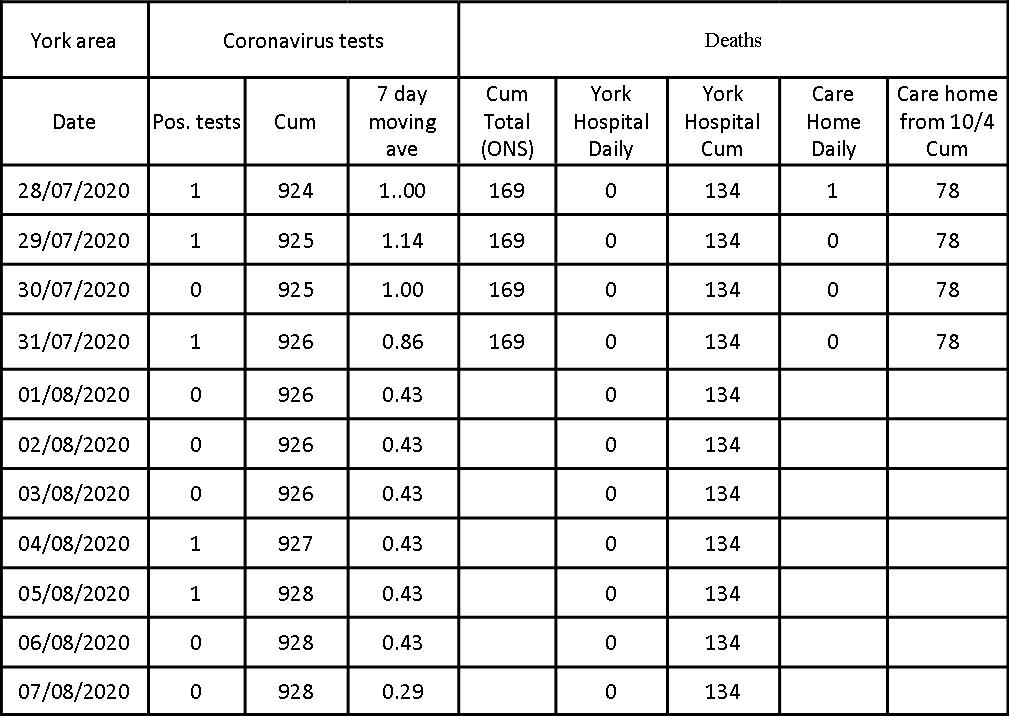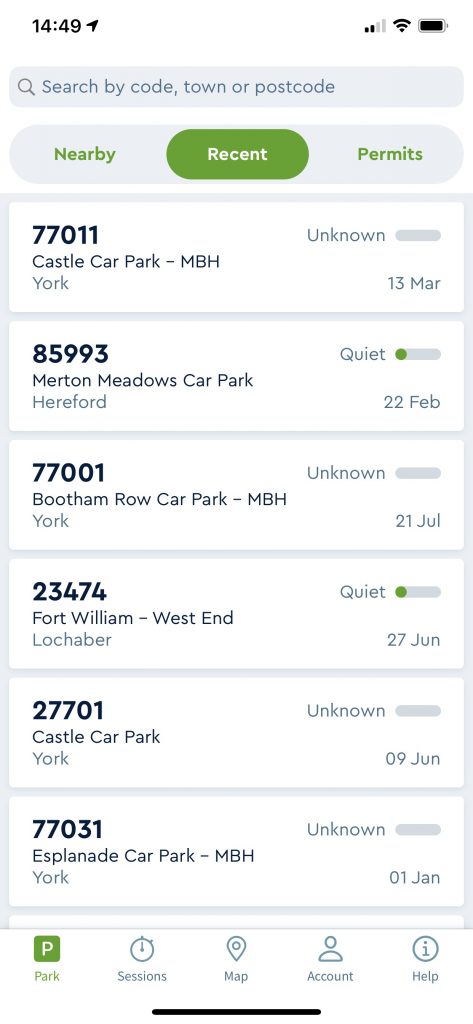Deaths and test results
No additional hospital deaths announced in York today. However, deaths in hospitals elsewhere in Yorkshire & the North East were higher than in other parts of the country.
There have been no additional positive test results in York today. We are currently experiencing about 3 new cases each week.
The latest figures released by the government today suggest that 0.05% of these tested in the community in Yorkshire and Humberside recorded positive results. New infection rates dropped during June but increased again towards the end of July.

Council commentary
The Council has updated its commentary on the pandemic on the open data web site. They say
DIAGNOSED CASES (Pillar 1 and 2 combined)
• As at 6.8.20 York has had 928 cases, a rate of 440.6 per 100,000 of population. The England rate is 472.3. The Yorkshire & Humber rate is 594.6. The most recent cases in York had a test specimen date of 3.8.20 (2 cases).
• The PHE ‘Exceedance’ rating compares the no. of new cases over a 14 day period with the previous 6 weeks and provides a RAG rating to indicate if the previously observed trend in the no. of new cases is worsening. The latest rating for York (4.8.20) is Amber. The rating was triggered by a higher than ‘expected’ number of cases per 100 tests once in the last 14 days (3 cases with a specimen date of 25.7.20). We know that in recent weeks the number of cases have been low in York which has an effect on the thresholds used to determine the RAG rating – a small change can mean the difference between a red, amber and green rating. The exceedance report should not be considered in isolation but in context alongside other factors such as the recent total number of cases, COVID related deaths, outbreaks as well as changes in the local testing regime and local hotspot analysis.
• The latest weekly National Covid-19 Surveillance Report released on 31.7.20 and covering the week up to 26.7.20, showed that the 7 day rate of new COVID-19 cases per 100,000 population tested under Pillar 1 and 2 was 4.29 for York. York was ranked 73rd out of 150 local authorities (with 1 being the lowest rate).
• The latest confirmed 7 day rate of new COVID-19 cases per 100,000 population for York is 2.85. This is for the 7 day period up to 31.7.20. This excludes cases with a sample date in the last few days due to partial data and lags in reporting. The national average is 8.8 and the regional average is 15.7.
• As at 4.8.20, the latest 7 day positivity rate in York (Pillar 2 only) was 0.33% (5 positives out of 1,528 tests). The positivity rate in York is lower than national (1.2%) and regional (1.8%) averages.
Deaths
The two sources about deaths from Covid-19 at LA level are ONS data and local registrar data. They are derived from the same source (civil registration data). ONS data is more comprehensive as it includes deaths of York residents which have occurred and been registered outside York. Local registrar data is useful as it provides a breakdown by age and gender. The most recently available data is summarised below:
• ONS weekly data: For deaths occurring up to 24th July 2020 and registered up to 1st August 2020, 169 deaths were recorded as having occurred for CYC residents (82 in hospital, 74 in care homes, 9 at home, 3 in a hospice and 1 in an ‘other communal establishment’). The number of deaths per 100,000 of population in York is 80.24 which is lower than the national average of 87.08
• ‘Excess’ deaths (ONS). In week 30 (18 July to 24 July), 20 deaths occurred in York, which is 11 fewer than the average weekly number for 2014-18. The peak week for ‘excess’ deaths and for Covid deaths was week18 (25 April to 1 May).
• Local Registrar data: In the weekly data received on 3.8.20 (for deaths occurring up to 29.7.20), a cumulative total of 161 deaths of CYC residents where COVID-19 was mentioned (confirmed or suspected) on the death certificate, have been registered. The average age of the people who died was 82.4, with an age range of 53-104. The age profile of those dying in York is slightly older than the national average. 85 of the 161 were male (52.8%), slightly less than the national average (55%). 81 of the deaths occurred in hospital and 80 were community deaths (e.g. at home or in a care home or hospice). 69 people (42.9%) died in nursing /care homes (the national average is 29.6%). In addition 13 people (8.1%) who normally resided in nursing/care homes in the CYC area, died in hospital.
Data on deaths occurring in hospital are shown below. Deaths are initially reported for York NHS Foundation Trust which includes Scarborough Hospital and the further breakdown by site can be delayed. From local registrar data, 58.5% of COVID-19 deaths occurring at York Hospital have been CYC residents. (NB NHS Trusts record deaths following a positive covid-19 test whereas ONS record deaths where covid-19 in mentioned on the death certificate so the totals are not the same).
• Deaths at York Hospital: As at 6.8.20, 134 deaths of people who had tested positive for COVID-19 and were being cared for at York Hospital have been reported. 214 deaths have been reported by the wider York NHS Trust.

Call for parking App info to be updated
We have called on the Council and its RingGo partner to provide parking space availability information on their parking app.
The information is provided by RingGo for car parks in other towns and cities.
New freephone line for those in mental distress
NHS Tees, Esk Wear and Valley have introduced a new freephone line which will make it easier for people in mental distress to access urgent help.
People in York, including children and older people, can contact their local TEWV crisis service on freephone number : 0800 0516171.
Following the success of the Trust’s single point of access telephone number launched earlier in the year, and in response to national guidance, the freephone line will help reduce barriers to accessing help in a mental health emergency.
Open 24 hours a day, seven days a week, callers, including those with learning disabilities and/or autism, will be offered a series of options which will divert them to their local crisis service. People calling the existing single point of access number will automatically be diverted to the freephone line with a view to this replacing the 0300 number in the coming months.
For more information visit: https://www.tewv.nhs.uk/freephone-line-for-those-in-mental-distress/
Additional facemask requirements from tomorrow (Saturday)
In addition to existing locations facemasks will be required at
- Auction Houses
- Bingo Halls
- Cinemas
- Community Centres
- Concert Halls
- Funeral Directors
- Indoor Entertainment Venues (amusement Arcades, Funfairs, Adventure Activities E.g. Laser Quest, Go-karting, Escape Rooms, Heritage Sites Etc)
- Libraries and Public Reading Rooms
- Massage Centres
- Museums, Galleries, Aquariums, Indoor Zoos or Visitor Farms, or Other Indoor Tourist, Heritage or Cultural Sites
- Nail, Beauty, Hair Salons and Barbers – Other Than Where Necessary to Remove for Treatments
- Place of Worship
- Premises Providing Professional, Legal or Financial Services
- Public Areas in Hotels and Hostels
- Social Clubs
- Storage and Distribution Facilities
- Tattoo and Piercing Parlours
- Theatres
- Veterinary Services
Job Retention Bonus
The government is introducing a new Job Retention Bonus to provide additional support to employers who keep on their furloughed employees in meaningful employment, after the government’s Coronavirus Job Retention Scheme ends on 31 October 2020.
Government have so far released an overview of the eligibility requirements and what employers need to do now to claim the bonus. Full guidance will be published by the end of September.
Find out more here: https://www.gov.uk/government/publications/job-retention-bonus/job-retention-bonus
Government Plan for Jobs from 1 August
The Chancellor’s Plan for Jobs announcement in July included a range of incentives that are available to employers recruiting apprentices, including those that have previously been made redundant. Incentives include:
| a new payment of £2,000 to employers in England for each new apprentice employers hire, aged under 25, and a £1,500 payment for each new apprentice they hire aged 25 and over, from 1st August 2020 to 31st January 2021, for new recruits. These payments are in addition to the existing £1,000 payment for new 16-18 year-old apprentices, and those aged under 25 with an Education, Health and Care Plan. an additional £111 million this year for traineeships in England, to triple participation in traineeships. Government will fund employers who provide trainees with work experience at a rate of £1,000 per trainee and expand eligibility for traineeships to those with Level 3 qualifications and below. an additional £32 million funding over the next two years for the National Careers Service so that 269,000 more people in England can receive personalised advice on training and work. A Job Retention Bonus – a one-off payment of £1,000 to UK employers for every furloughed employee who remains continuously employed through to the end of January 2021. |
Incentives payments can be claimed by employers from September and will be paid in January 2021. Find out more by visiting: https://www.gov.uk/government/news/rishis-plan-for-jobs-will-help-britain-bounce-back
